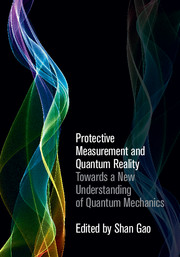Book contents
- Frontmatter
- Dedication
- Contents
- List of Contributors
- Preface
- Acknowledgements
- 1 Protective measurement: an introduction
- Part I Fundamentals and applications
- Part II Meanings and implications
- 7 Measurement and metaphysics
- 8 Protective measurement and the explanatory gambit
- 9 Realism and instrumentalism about the wave function: how should we choose?
- 10 Protective measurement and the PBR theorem
- 11 The roads not taken: empty waves, wave function collapse and protective measurement in quantum theory
- 12 Implications of protective measurement on de Broglie–Bohm trajectories
- 13 Entanglement, scaling, and the meaning of the wave function in protective measurement
- 14 Protective measurement and the nature of the wave function within the primitive ontology approach
- 15 Reality and meaning of the wave function
- Index
- References
15 - Reality and meaning of the wave function
from Part II - Meanings and implications
Published online by Cambridge University Press: 05 January 2015
- Frontmatter
- Dedication
- Contents
- List of Contributors
- Preface
- Acknowledgements
- 1 Protective measurement: an introduction
- Part I Fundamentals and applications
- Part II Meanings and implications
- 7 Measurement and metaphysics
- 8 Protective measurement and the explanatory gambit
- 9 Realism and instrumentalism about the wave function: how should we choose?
- 10 Protective measurement and the PBR theorem
- 11 The roads not taken: empty waves, wave function collapse and protective measurement in quantum theory
- 12 Implications of protective measurement on de Broglie–Bohm trajectories
- 13 Entanglement, scaling, and the meaning of the wave function in protective measurement
- 14 Protective measurement and the nature of the wave function within the primitive ontology approach
- 15 Reality and meaning of the wave function
- Index
- References
Summary
The wave function gives not the density of stuff, but gives rather (on squaring its modulus) the density of probability. Probability of what, exactly? Not of the electron being there, but of the electron being found there, if its position is ‘measured’. Why this aversion to ‘being’ and insistence on ‘finding’? The founding fathers were unable to form a clear picture of things on the remote atomic scale.
John S. Bell (1990)Introduction
The physical meaning of the wave function is an important interpretative problem of quantum mechanics. Notwithstanding nearly ninety years of development of the theory, it is still an unsolved issue. During recent years, more and more research has been done on the ontological status and meaning of the wave function (see, e.g. Monton, 2002; Lewis, 2004; Gao, 2011a, 2011b; Pusey, Barrett and Rudolph, 2012; Ney and Albert, 2013). In particular, Pusey, Barrett and Rudolph (2012) demonstrated that under certain non-trivial assumptions such as the preparation independence assumption, the wave function of a quantum system is a representation of the physical state of the system. This poses a further question, namely whether the reality of the wave function can be argued without resorting to non-trivial assumptions. Moreover, a harder problem is to determine the ontological meaning of the wave function, which is still a hot topic of debate in the realistic alternatives to quantum mechanics such as the de Broglie–Bohm theory or Bohmian mechanics (Belot, 2012).
In this chapter, we will first give a clearer argument for the reality of the wave function in terms of protective measurements, which does not depend on non-trivial assumptions and can also overcome existing objections. Next, based on an analysis of the mass and charge properties of a quantum system, we will propose a new ontological interpretation of the wave function. According to this interpretation, the wave function of an N-body system represents the state of ergodic motion of N particles.
Information
- Type
- Chapter
- Information
- Protective Measurement and Quantum RealityTowards a New Understanding of Quantum Mechanics, pp. 211 - 229Publisher: Cambridge University PressPrint publication year: 2015
References
Accessibility standard: Unknown
- 4
- Cited by
